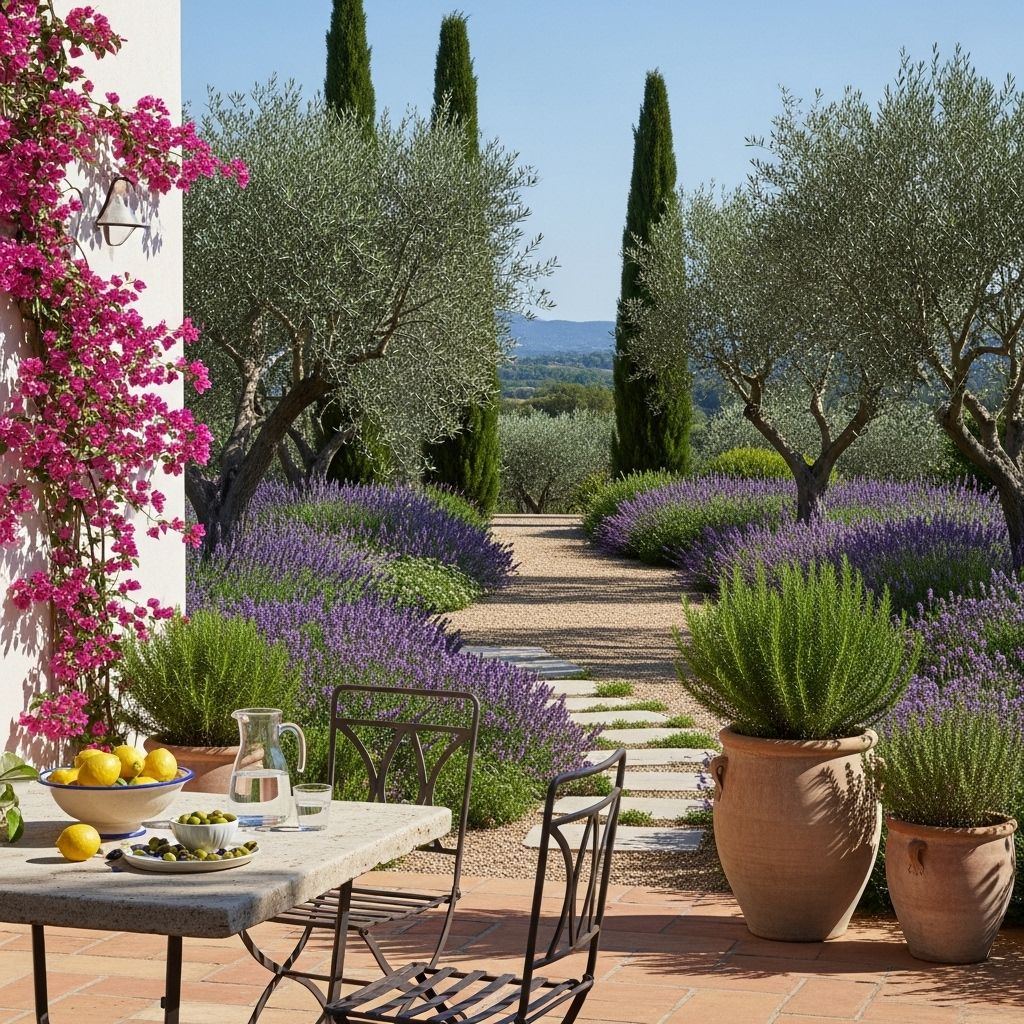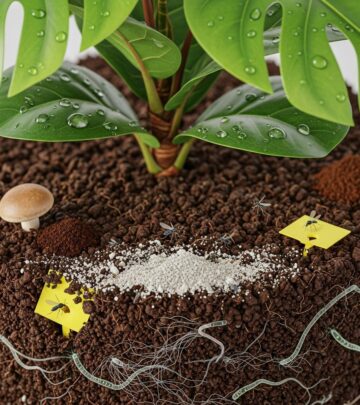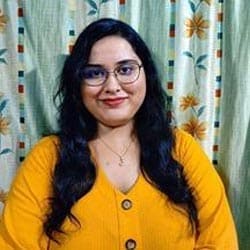Mediterranean Garden Ideas: 10 Provençal Outdoor Inspirations
Transform your outdoor space with timeless, sun-drenched Provençal garden ideas—embrace texture, fragrance, and relaxed southern charm.

Image: HearthJunction Design Team
10 Provençal Garden Ideas to Inspire Your Outdoor Retreat
Sun-drenched Provence, with its craggy limestone hills, fields of lavender, and rustic stone villages, offers an endless well of inspiration for garden lovers. The Provençal garden is at once rustic and elegant, marked by vibrant textures, earthy scents, and a relaxed approach to beauty. Whether you dream of a fragrant patio or a meditative sculpted landscape, Provence provides a blueprint for timeless, low-maintenance outdoor living. Here are ten essential ideas to infuse your garden with Mediterranean magic.
1. Start with Structure: Sculpted Evergreens
Provençal gardens are defined by structure as much as botanical variety. The backbone often consists of evergreen shrubs—think boxwood, yew, and juniper—shaped into geometric or organic forms. Legendary garden designer Nicole de Vésian’s La Louve in the Luberon is famed for its cloud-like clipped shrubs, which serve as living architecture and provide a year-round framework .
- Use boxwood balls or spirals for visual focus.
- Mix shapes—pillowy mounds, tall cones, and neat hedges—to add movement and interest.
- Plant in naturalistic drifts rather than rigid lines for a relaxed, fluid look.
2. Harness Subdued, Harmonious Color Palettes
The Provençal color scheme is understated yet sophisticated. The garden’s base is made up of silvery greens and soft grays—think olive, sage, and rosemary—punctuated with lavender blues, pale whites, and the occasional pop of sun-bleached color . Flowers never overwhelm the foundation but instead create gentle contrasts amid the foliage.
- Opt for plants with silvery or variegated leaves—like lavender and Artemisia—for natural brightness.
- Stick to whites, soft blues, and occasional yellows for a cohesive effect.
- Blend in green structure with pops of floral color in strategic spots.
3. Celebrate Texture: Mix Leaves and Surfaces
Texture is as important as color in Provence. Pair glossy laurel with fuzzy sage, fine-leaved thyme with robust rosemary, and soft gray lamb’s ear with leathery cistus. Paths and terraces of pebble or gravel contrast beautifully with lush planting, while stone edging adds structure without formality .
- Layer plants with different leaf sizes, shapes, and finishes.
- Use gravel, decomposed granite, or stone pavers for paths and patios.
- Define beds with chunky stone or natural timber rather than manufactured borders.
4. Drought-Tolerant Planting: Thrive in Sun and Dryness
The Provençal climate is hot and dry, so gardens are filled with drought-loving species that flourish with minimal fuss. Standout plants include lavender, rosemary, thyme, santolina, cistus, and upright irises. Grouping plants with similar water needs not only saves effort but lends an air of effortless abundance .
- Create swathes of aromatic herbs and Mediterranean perennials.
- Limit your selection to truly tough plants for easy gardening.
- Water deeply but infrequently to encourage deep roots.
5. Gravel and Pebbles: The Provençal Flooring
Gravel is the quintessential Provençal surface for patios, paths, and terraces. It keeps the ground cool, offers excellent drainage, and evokes casual French charm. Use pale, buff, or gray stone chippings to mimic the sun-bleached look of southern France .
- Lay gravel generously around outdoor seating and dining spaces.
- Edge gravel areas with stones or clipped hedges for definition.
- Let self-sown plants—like thyme or sedum—soften the edges.
6. Stone Walls and Terraces: Authentic Mediterranean Hardscape
Rugged stone walls, steps, and terraces are foundational in Provence, where gardens often perch on slopes or nestle beside ancient farmhouses. These hardscapes offer structure, elevate planting, and create microclimates for sun-loving plants .
- Use locally sourced or reclaimed stone for authenticity.
- Design terraced levels to enable planting at different heights.
- Build small retaining walls as seating or to define spaces.
7. Fountains and Water Features: A Source of Coolness and Calm
Water is precious in southern France and is used sparingly—but meaningfully. Classic Provençal gardens feature modest stone basins or wall fountains. The gentle sound of trickling water adds tranquility, cools the air, and attracts birds and pollinators .
- Install a limestone or terracotta trough as a simple central feature.
- Place a fountain near an outdoor seating area to enhance relaxation.
- Grow shade-loving ferns or moss around the water for an oasis effect.
8. Shaded Seating: Pergolas, Arbors, and Canopies
With the Mediterranean sun beating down, shade is vital. Pergolas and arbors draped with wisteria, grapevine, or climbing roses create cool retreats. Consider using rustic wooden beams, stone columns, or reclaimed ironwork for supports .
- Plant climbing vines for natural shade and seasonal interest.
- Use gauzy outdoor curtains or woven reed mats to filter sunlight.
- Position seating to take advantage of breezes and dappled light.
9. Create Outdoor Rooms: Defined Spaces for Living
Provençal gardens often feature distinct “rooms” or zones with specific functions—dining, lounging, potager (kitchen garden), or contemplation corners. Use hedges, low walls, or rows of lavender to subtly delineate these spaces .
- Designate an alfresco dining area with gravel underfoot and dappled shade above.
- Define vegetable or herb plots with boxwood or lavender hedges.
- Create quiet nooks for reading amid scented planting or near water features.
10. Scented Planting: Aromatherapy on the Breeze
No Provençal garden is complete without a tapestry of fragrance. Lavender, rosemary, thyme, and savory line every path and terrace, while roses and jasmine perfume the evening air. Scent is as integral as appearance—your garden should delight all the senses .
- Edge walkways with low-growing aromatic herbs.
- Position scented plants near doors, windows, and seating areas.
- Include night-flowering jasmine or nicotiana for evening aroma.
Bringing Provence Home: Practical Tips
- Embrace Imperfection: Provençal gardens are relaxed—let plants sprawl and mingle naturally.
- Work with Your Climate: Choose drought-tolerant, low-maintenance plants suited to your region.
- Use Local Materials: Whenever possible, utilize regional stone, gravel, and timber for authenticity.
- Mix Old and New: Blend traditional features with modern comforts for contemporary Provençal style.
Table: Key Features of a Provençal Garden
| Feature | Description | Why It Matters |
|---|---|---|
| Clipped Evergreens | Boxwood, yew, juniper—shaped into mounds or cones | Structure year-round; visual movement |
| Subtle Color Palette | Silvery greens, soft blues, whites | Evokes local flora, timeless look |
| Stone Hardscape | Walls, terraces, fountains | Defines space, adds age and gravitas |
| Gravel Surfaces | Pebble patios and paths | Drainage, cooling, rustic charm |
| Scented Planting | Lavender, rosemary, thyme | Multi-sensory appeal, attracts pollinators |
| Outdoor Rooms | Spaces for dining, lounging, potager | Functional, inviting, easy to use |
Frequently Asked Questions (FAQ)
Q: What are the essential plants for a Provençal-style garden?
A: The core plants include lavender, rosemary, thyme, boxwood, olive, cypress, iris, santolina, and various Mediterranean perennials. Drought-tolerant and aromatic species are vital for authenticity and resilience.
Q: How can I evoke the Provençal spirit in a small urban garden?
A: Even in small spaces, focus on structure with clipped evergreens, use gravel or stone for the ground, and add potted lavender, rosemary, or citrus. A small wall fountain and a bistro set can transform a patio or balcony.
Q: Do I need a lot of sun to create a Provençal garden?
A: Most Provençal plants need at least six hours of direct sun daily. If your space is shadier, include tougher evergreens and opt for Mediterranean plants tolerant of partial shade, such as bay laurel and some salvias.
Q: What maintenance is required for this style of garden?
A: Provençal gardens are designed for low fuss—regular light pruning of shrubs for shape, annual cutting of herbaceous perennials, and occasional gravel raking. Minimal watering is needed once plants are established.
Q: How can I incorporate edibles into a Provence-inspired design?
A: Provençal gardens often feature a potager, or kitchen garden, with neat rows of herbs, tomatoes, peppers, garlic, and beans. Use low hedges or stone edging to separate edible beds.
Conclusion: The Spirit of Provence, Anywhere
Creating a Provençal-inspired garden is less about copying plant lists and more about embracing a philosophy: structure, subtlety, fragrance, and a relaxed relationship with beauty. Whether you have a vast country plot or a city balcony, the timeless elements of Provence—clipped evergreens, scented herbs, stonework, shaded seating, and harmonious color—can transform any outdoor space into an evocative sanctuary that grows lovelier with each passing season.
References
- https://www.gardenista.com/posts/10-garden-ideas-steal-provence/
- https://www.gardenista.com/posts/nicole-de-vesian-a-magical-garden-where-clouds-grow-on-a-hillside-in-provence/
- https://www.gardenista.com/web-stories/10-garden-ideas-to-steal-from-provence-gardenista-zvgjz/
- https://www.gardenista.com/posts/calanques-plant-hike-foraging/
- https://www.finegardening.com/article/the-beauty-and-simplicity-of-a-provencal-style-garden
Read full bio of Srija Burman












